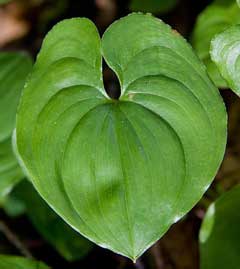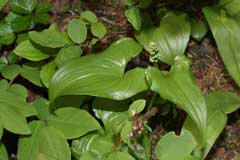 |
|
http://commons.wikimedia.org/wiki/User:%CE%A364 |
 |
| http://commons.wikimedia.org/wiki/User:Wsiegmund |
Translate this page:
Summary
Physical Characteristics

 Maianthemum dilatatum is a PERENNIAL growing to 0.2 m (0ft 8in) by 0.5 m (1ft 8in).
Maianthemum dilatatum is a PERENNIAL growing to 0.2 m (0ft 8in) by 0.5 m (1ft 8in).
See above for USDA hardiness. It is hardy to UK zone 3 and is not frost tender. It is in flower from March to April. The species is hermaphrodite (has both male and female organs) and is pollinated by Insects.
Suitable for: light (sandy), medium (loamy) and heavy (clay) soils. Suitable pH: mildly acid, neutral and basic (mildly alkaline) soils. It can grow in full shade (deep woodland) or semi-shade (light woodland). It prefers moist soil.
UK Hardiness Map
US Hardiness Map
Synonyms
M. kamtschaticum.
Plant Habitats
Woodland Garden Dappled Shade; Shady Edge; not Deep Shade;
Edible Uses
Edible Parts: Fruit Leaves
Edible Uses:
Fruit - raw or dried for later use[118, 177]. The fruits are about the size of small peas and are produced in terminal clusters on the plants, they are not regarded very highly[256]. North American Indian children would eat the raw unripe green berries straight from the plant[256]. Adults would usually harvest the green berries and then store them in water until they turned red and were soft[256]. Alternatively they would dry the green berries and then boil them for a few minutes[256]. Young leaves - cooked[177].
References More on Edible Uses
Medicinal Uses
Plants For A Future can not take any responsibility for any adverse effects from the use of plants. Always seek advice from a professional before using a plant medicinally.
Infertility Ophthalmic Poultice TB
A poultice made of the whole or the mashed leaves has been applied to boils, burns, cuts and wounds[257]. The fruit has been used as a good medicine in the treatment of tuberculosis[257]. The root has been chewed in order to correct sterility[257]. (This probably means to restore fertility[K]) An infusion of the pounded roots has been used as a wash for sore eyes, whilst the chewed roots have been used as a poultice on the eyes[257].
References More on Medicinal Uses
The Bookshop: Edible Plant Books
Our Latest books on Perennial Plants For Food Forests and Permaculture Gardens in paperback or digital formats.

Edible Tropical Plants
Food Forest Plants for Hotter Conditions: 250+ Plants For Tropical Food Forests & Permaculture Gardens.
More

Edible Temperate Plants
Plants for Your Food Forest: 500 Plants for Temperate Food Forests & Permaculture Gardens.
More

More Books
PFAF have eight books available in paperback and digital formats. Browse the shop for more information.
Shop Now
Other Uses
References More on Other Uses
Cultivation details
Requires a cool shady moist but not wet position[1, 187]. Plants tolerate warm summers only if the soil remains moist[200]. A mat forming plant, it can be invasive in good conditions[200].
References Carbon Farming Information and Carbon Sequestration Information
Temperature Converter
Type a value in the Celsius field to convert the value to Fahrenheit:
Fahrenheit:
The PFAF Bookshop
Plants For A Future have a number of books available in paperback and digital form. Book titles include Edible Plants, Edible Perennials, Edible Trees,Edible Shrubs, Woodland Gardening, and Temperate Food Forest Plants. Our new book is Food Forest Plants For Hotter Conditions (Tropical and Sub-Tropical).
Shop Now
Plant Propagation
Seed - best sown quite thinly it as soon as it is ripe in a cold frame, it should germinate in the spring. Stored seed should be sown in late winter in a cold frame, it might take 18 months to germinate. Allow the seedlings to grow on in the pot for their first year, giving liquid feeds as necessary to ensure that they do not go hungry. Divide the plants into individual pots once they have died down in late summer. Grow them on in pots for another year or more until large enough to plant out[K]. Division as new growth commences in the spring. Larger clumps can be replanted direct into their permanent positions, though it is best to pot up smaller clumps and grow them on in a cold frame until they are rooting well. Plant them out in the spring.
Other Names
If available other names are mentioned here
Native Range
TEMPERATE ASIA: Russian Federation (Chita), Russian Federation (Habarovskij kraj, Primorye, Kamcatskij kraj, Sakhalin), Korea, Japan (Hokkaidô, Honshu, Kyushu, Shikoku) NORTHERN AMERICA: Canada (Yukon (southwest), British Columbia), United States (Idaho, Oregon, Washington, California, Alaska)
Weed Potential
Right plant wrong place. We are currently updating this section.
Please note that a plant may be invasive in one area but may not in your area so it's worth checking.
Conservation Status
IUCN Red List of Threatened Plants Status :

Growth: S = slow M = medium F = fast. Soil: L = light (sandy) M = medium H = heavy (clay). pH: A = acid N = neutral B = basic (alkaline). Shade: F = full shade S = semi-shade N = no shade. Moisture: D = dry M = Moist We = wet Wa = water.
Now available:
Food Forest Plants for Mediterranean Conditions
350+ Perennial Plants For Mediterranean and Drier Food Forests and Permaculture Gardens.
[Paperback and eBook]
This is the third in Plants For A Future's series of plant guides for food forests tailored to
specific climate zones. Following volumes on temperate and tropical ecosystems, this book focuses
on species suited to Mediterranean conditions—regions with hot, dry summers and cool, wet winters,
often facing the added challenge of climate change.
Read More
Expert comment
Author
(Wood.)Nels.&MacBr.
Botanical References
160270
Links / References
For a list of references used on this page please go here
Readers comment
| Add a comment |
|
If you have important information about this plant that may help other users please add a comment or link below. Only comments or links that are felt to be directly relevant to a plant will be included. If you think a comment/link or information contained on this page is inaccurate or misleading we would welcome your feedback at [email protected]. If you have questions about a plant please use the Forum on this website as we do not have the resources to answer questions ourselves.
* Please note: the comments by website users are not necessarily those held by PFAF and may give misleading or inaccurate information.
To leave a comment please Register or login here All comments need to be approved so will not appear immediately.
|
Subject : Maianthemum dilatatum
|
|
|
|